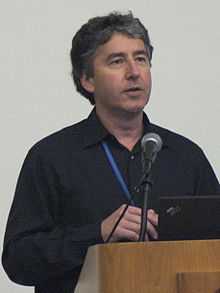Gerald Joyce
| Gerald Joyce | |
|---|---|
 Gerald Joyce, 2010 | |
| Born | 1956 (age 57–58) |
| Institutions | The Scripps Research Institute |
| Alma mater |
University of Chicago University of California, San Diego |
| Known for | in vitro evolution |
| Website | |
| www.scripps.edu/joyce | |
Gerald Francis Joyce (born 1956) is a professor and researcher at The Scripps Research Institute, best known for his work on in vitro evolution of catalytic RNA molecules and the origins of life.
Joyce received his Bachelor of Arts from the University of Chicago in 1978, completed his M.D. and Ph.D. at the University of California, San Diego in 1984. He was a postdoctoral fellow and senior research associate at the Salk Institute from 1985 to 1989, and joined Scripps in 1989. Joyce was elected to the U.S. National Academy of Sciences in 2001. He served as Dean of the Faculty at Scripps from 2006 to 2011,[1] during which time he was instrumental in founding a second campus in Jupiter, Florida.[2]
Joyce received the Urey medal of the International Society for the Study of the Origin of Life (ISSOL) in 2005. [3] In 2009, Joyce's lab was the first to produce a self-replicating in vitro system, capable of exponential growth and continuing evolution, composed entirely of RNA enzymes. [4][5]
Awards
- National Academy of Sciences Award in Molecular Biology, 1994
- Pfizer Award in Enzyme Chemistry, 1995
- Herbert W. Dickerman Award, 1997
- Hans Sigrist Prize, 1997
References
- ↑ "Joyce, Gerald" in VIVO
- ↑ "Welcome to Jupiter, Scripps Florida" pamphlet
- ↑ "ISSOL Medals and Honors"
- ↑ Lincoln, T. A.; Joyce, G. F. (2009). "Self-Sustained Replication of an RNA Enzyme". Science 323 (5918): 1229–1232. doi:10.1126/science.1167856. PMC 2652413. PMID 19131595.
- ↑ Wilson da Silva, "Life-like evolution in a test tube", Cosmos Magazine Online
External links
- Summary of Joyce's research
- Gerald Joyce profile
- Joyce receiving the Urey Medal
- The Joyce Laboratory at The Scripps Research Institute
| ||||||||